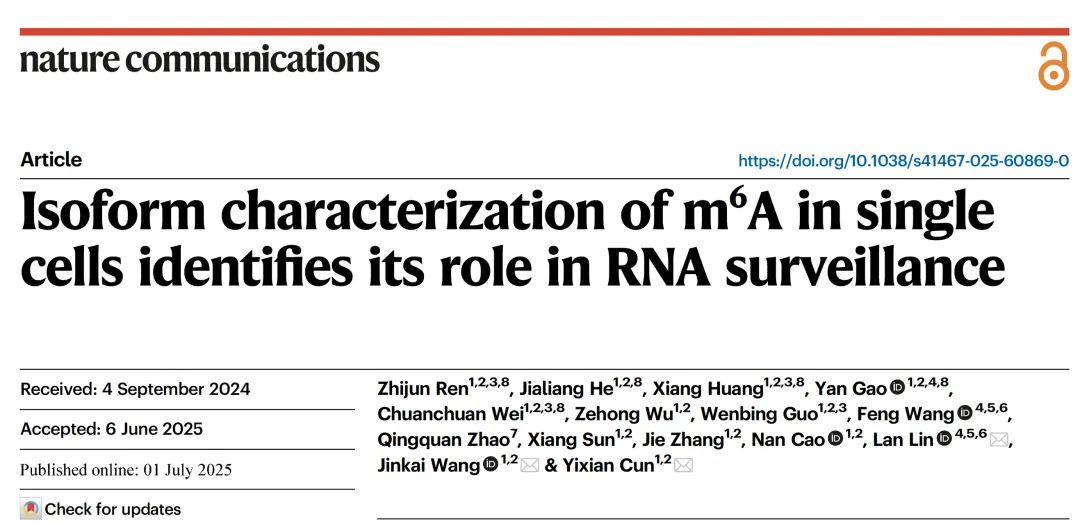NAT COMMUN | Wang Jinkai's research team cooperates with Philadelphia Children's Hospital to reveal the mechanism of m6A mediating novel RNA quality control through single-cell nanopore sequencing
Eukaryotic cells rely on the classical RNA quality control mechanism, nonsense-mediated RNA decay (NMD), to detect premature termination codons. Consequently, 95.4% of normal termination codons are located in the last exon. However, eukaryotic genes have generally evolved various distinctive patterns beyond this. For example, 84% of genes do not contain intermediate exons longer than 400nt, and termination codons in the last exon are generally close to the 5' end. This suggests that the formation of these special patterns may also be a requirement for RNA quality control in eukaryotic cells. Nevertheless, the specific type of quality control that necessitates genes to develop these features remains unclear.

A growing body of research indicates that RNA processing regulates the formation of m⁶A. The exon junction complex (EJC) inhibits m⁶A formation, making it difficult for the region within 200nt near the EJC to be modified by m⁶A. On the other hand, m⁶A is mainly enriched in the 3'UTR region near the termination codon. Recent studies have also found that m⁶A in the CDS region, rather than the 3'UTR region, can promote m⁶A-mediated degradation. This suggests that different RNA processing methods may lead to differences in m⁶A. For instance, a slight change in the position of the termination codon may shift the main m⁶A signal from the 3'UTR to the CDS region. However, the distribution pattern of m⁶A on full-length transcripts remains unclear, especially at the single-cell level, which hinders in-depth research on this scientific issue.
On July 1st, the research group led by Professor Wang Jinkai from the Zhongshan School of Medicine, in collaboration with the Children's Hospital of Philadelphia in the United States, published a research paper entitled "Isoform characterization of m⁶A in single cells identifies its role in RNA surveillance" in Nature Communications. This paper developed the m⁶A-isoSC-seq technology, which uses single-cell Oxford Nanopore long-read sequencing to measure the m⁶A modification level through the APOBEC1-YTH-induced C-to-U mutation rate. It is the first to realize the mapping of m⁶A modification profiles of full-length transcripts at single-cell resolution. The research team found that, compared with other transcripts of the same gene, specifically highly modified transcripts are mainly enriched in incorrectly spliced transcripts and truncated transcripts formed by intronic polyadenylation (IpA). Incorrect splicing, especially intron retention, tends to form long, highly m⁶A-modified intermediate exons. IpA transcripts are generated by polyadenylation at the polyadenylation signal in the intronic region during transcription, which causes IpA to select a segment of the original intron as the last exon, forming a truncated RNA. In this case, the randomly generated termination codon is usually farther from the 5' end of the last exon than the normal termination codon, thereby placing the main distribution region of m⁶A in the CDS region rather than the 3'UTR region of the IpA RNA, which in turn promotes the degradation of IpA RNA and realizes the surveillance of IpA RNA. The study also found that m⁶A-mediated degradation of incorrectly processed RNA is independent of the classical NMD pathway but depends on the newly reported m⁶A-CDS decay pathway.
This study not only developed a new technology for analyzing m⁶A modifications at the single-cell full-length RNA level but also revealed that m⁶A is a very important pathway for RNA quality control in eukaryotic cells. It also provides a new insight into the mechanism of diseases caused by toxic proteins produced by abnormal cellular RNA surveillance and mediated by dominant-negative effects.
The corresponding authors of this research paper are Dr. Cun Yixian (postdoctoral fellow in Professor Wang Jinkai's group), Professor Wang Jinkai from the Zhongshan School of Medicine, Sun Yat-sen University, and Professor Lan Lin from the Children's Hospital of Philadelphia, USA. The co-first authors are Ren Zhijun (postdoctoral fellow), He Jialiang (Ph.D. student), Huang Xiang (postdoctoral fellow), Gao Yan (postdoctoral fellow, later joined the Children's Hospital of Philadelphia), and Wei Chuanchuan (postdoctoral fellow) from Professor Wang Jinkai's group. This work was supported by the National Natural Science Foundation of China, the Guangdong Provincial Science Foundation, and the Postdoctoral Foundation.


